Fatigue Crack Growth Studies under Mixed-Mode Loading in AISI 316 Stainless Steel
Abstract
:1. Introduction
2. ANSYS Procedure for Fatigue Analysis
- Separating technology: this feature allows for the separation of different components within a model, making it possible to simulate the deformation of individual parts separately. This is particularly useful when simulating complex structures that have many moving parts.
- Morphing technology: this feature enables the morphing of a mesh to match the deformation of the structure during simulation. This is achieved by updating the nodal positions of the mesh based on the deformation of the structure.
- Adaptive remeshing technology: this feature enables the automatic refinement of the mesh in regions where high deformation gradients are present, improving the accuracy of the simulation. This feature is especially useful in simulating crack propagation, where accurate stress gradient capture necessitates mesh refinement around the crack tip.
3. Numerical Results and Discussions
Compact Tensile Shear (CTS) Specimen
4. Conclusions
- Investigating the in-plane mixed-mode I/II fatigue crack growth behavior of the AISI 316 austenitic stainless steel alloy is crucial for ensuring the safety and reliability of marine structures and various structural components subjected to mixed-mode loading.
- The 45-degree loading angle in a compact tension shear specimen corresponds to the maximum shear stress and maximum von Mises stress components, indicating a pure shear loading condition where the tensile and compressive stress components are balanced and cancel each other out.
- Advanced numerical simulation techniques such as the SMART crack growth feature in ANSYS APDL 19.2 have enabled more efficient and accurate modeling of mixed-mode fatigue crack growth in CTS specimens. This feature automates the process of crack creation and growth and uses advanced algorithms to predict the crack growth path.
- The findings may be useful for improving the design and optimization of materials for marine applications and structural components subjected to mixed-mode loading.
Author Contributions
Funding
Institutional Review Board Statement
Informed Consent Statement
Data Availability Statement
Conflicts of Interest
References
- Rozumek, D.; Marciniak, Z.; Lesiuk, G.; Correia, J.A.; de Jesus, A.M. Experimental and numerical investigation of mixed mode I + II and I + III fatigue crack growth in S355J0 steel. Int. J. Fatigue 2018, 113, 160–170. [Google Scholar] [CrossRef]
- Chen, Q.; Guo, H.; Avery, K.; Kang, H.; Su, X. Mixed-mode fatigue crack growth and life prediction of an automotive adhesive bonding system. Eng. Fract. Mech. 2018, 189, 439–450. [Google Scholar] [CrossRef]
- Biner, S. Fatigue crack growth studies under mixed-mode loading. Int. J. Fatigue 2001, 23, 259–263. [Google Scholar] [CrossRef]
- Lesiuk, G.; Smolnicki, M.; Mech, R.; Zięty, A.; Fragassa, C. Analysis of fatigue crack growth under mixed mode (I + II) loading conditions in rail steel using CTS specimen. Eng. Fail. Anal. 2020, 109, 104354. [Google Scholar] [CrossRef]
- Qian, J.; Fatemi, A. Fatigue crack growth under mixed-mode I and II loading. Fatigue Fract. Eng. Mater. Struct. 1996, 19, 1277–1284. [Google Scholar] [CrossRef]
- Schijve, J. Fatigue of Structures and Materials, 2nd ed.; Springer Science & Business Media: Berlin/Heidelberg, Germany, 2008. [Google Scholar]
- Stephens, R.I.; Fatemi, A.; Stephens, R.R.; Fuchs, H.O. Metal Fatigue in Engineering; John Wiley & Sons: Hoboken, NJ, USA, 2000. [Google Scholar]
- Allen, R.; Booth, G.; Jutla, T. A review of fatigue crack growth characterisation by linear elastic fracture mechanics (LEFM). Part I—Principles and methods of data generation. Fatigue Fract. Eng. Mater. Struct. 1988, 11, 45–69. [Google Scholar] [CrossRef]
- Allen, R.; Booth, G.; Jutla, T. A review of fatigue crack growth characterisation by linear elastic fracture mechanics (LEFM). Part II—Advisory documents and applications within national standards. Fatigue Fract. Eng. Mater. Struct. 1988, 11, 71–108. [Google Scholar] [CrossRef]
- Wöhler, A. Versuche zur Ermittlung der auf die Eisenbahnwagenachsen einwirkenden Kräfte und die Widerstandsfähigkeit der Wagen-Achsen. Z. Für Bauwes. 1860, 10, 583–614. [Google Scholar]
- Coffin, L. Cyclic deformation and fatigue of metals. In Fatigue and Endurance of Metals [Russian Translation]; Elsevier: Amsterdam, The Netherlands, 1963; pp. 257–272. [Google Scholar]
- Paris, P.; Erdogan, F. A critical analysis of crack propagation laws. J. Basic Eng. 1963, 85, 528–533. [Google Scholar] [CrossRef]
- Alshoaibi, A.M. Fatigue crack growth analysis under constant amplitude loading using finite element method. Materials 2022, 15, 2937. [Google Scholar] [CrossRef]
- Demir, O.; Ayhan, A.O.; Sedat, I.; Lekesiz, H. Evaluation of mixed mode-I/II criteria for fatigue crack propagation using experiments and modeling. Chin. J. Aeronaut. 2018, 31, 1525–1534. [Google Scholar] [CrossRef]
- Fageehi, Y.A.; Alshoaibi, A.M. Numerical Simulation of Mixed-Mode Fatigue Crack Growth for Compact Tension Shear Specimen. Adv. Mater. Sci. Eng. 2020, 2020, 5426831. [Google Scholar] [CrossRef]
- Demir, O.; Ayhan, A.O.; İriç, S. A new specimen for mixed mode-I/II fracture tests: Modeling, experiments and criteria development. Eng. Fract. Mech. 2017, 178, 457–476. [Google Scholar] [CrossRef]
- Richard, H.; Benitz, K. A loading device for the creation of mixed mode in fracture mechanics. Int. J. Fract. 1983, 22, R55–R58. [Google Scholar] [CrossRef]
- Sander, M.; Richard, H. Experimental and numerical investigations on the influence of the loading direction on the fatigue crack growth. Int. J. Fatigue 2006, 28, 583–591. [Google Scholar] [CrossRef]
- Husaini, K.K.; Hanji, M.; Notomi, M. Investigations of the mixed mode crack growth behavior of an aluminum alloy. J. Eng. Appl. Sci 2016, 11, 885–890. [Google Scholar]
- Ayhan, A.O.; Demir, O. Computational modeling of three-dimensional mixed mode-I/II/III fatigue crack growth problems and experiments. Comput. Struct. 2021, 243, 106399. [Google Scholar] [CrossRef]
- Rozumek, D.; Marciniak, Z.; Lesiuk, G.; Correia, J. Mixed mode I/II/III fatigue crack growth in S355 steel. Procedia Struct. Integr. 2017, 5, 896–903. [Google Scholar] [CrossRef]
- Miao, X.-T.; Yu, Q.; Zhou, C.-Y.; Li, J.; Wang, Y.-Z.; He, X.-H. Experimental and numerical investigation on fracture behavior of CTS specimen under I-II mixed mode loading. Eur. J. Mech.-A/Solids 2018, 72, 235–244. [Google Scholar] [CrossRef]
- Malekan, M.; Khosravi, A.; St-Pierre, L. An Abaqus plug-in to simulate fatigue crack growth. Eng. Comput. 2021, 38, 2991–3005. [Google Scholar] [CrossRef]
- Rocha, A.; Akhavan-Safar, A.; Carbas, R.; Marques, E.; Goyal, R.; El-zein, M.; da Silva, L. Numerical analysis of mixed-mode fatigue crack growth of adhesive joints using CZM. Theor. Appl. Fract. Mech. 2020, 106, 102493. [Google Scholar] [CrossRef]
- Carter, B.; Wawrzynek, P.; Ingraffea, A. Automated 3-D crack growth simulation. Int. J. Numer. Methods Eng. 2000, 47, 229–253. [Google Scholar] [CrossRef]
- Nagarajappa, N.; Malipatil, S.G.; Majila, A.N.; Fernando, D.C.; Manjuprasad, M.; Manjunatha, C. Fatigue Crack Growth Prediction in a Nickel-Base Superalloy Under Spectrum Loads Using FRANC3D. Trans. Indian Natl. Acad. Eng. 2022, 7, 533–540. [Google Scholar] [CrossRef]
- Kuang, Y.; Wang, Y.; Xiang, P.; Tao, L.; Wang, K.; Fan, F.; Yang, J. Experimental and Theoretical Study on the Fatigue Crack Propagation in Stud Shear Connectors. Materials 2023, 16, 701. [Google Scholar] [CrossRef] [PubMed]
- Hou, J.; Goldstraw, M.; Maan, S.; Knop, M. An Evaluation of 3D Crack Growth Using ZENCRACK; Defence Science and Technology Organisation Victoria: Melbourne, Australia, 2001.
- Shahani, A.; Farrahi, A. Experimental investigation and numerical modeling of the fatigue crack growth in friction stir spot welding of lap-shear specimen. Int. J. Fatigue 2019, 125, 520–529. [Google Scholar] [CrossRef]
- Alshoaibi, A.M.; Fageehi, Y.A. 3D modelling of fatigue crack growth and life predictions using ANSYS. Ain Shams Eng. J. 2022, 13, 101636. [Google Scholar] [CrossRef]
- Alshoaibi, A.M.; Fageehi, Y.A. Numerical Analysis on Fatigue Crack Growth at Negative and Positive Stress Ratios. Materials 2023, 16, 3669. [Google Scholar] [CrossRef] [PubMed]
- Alshoaibi, A.M.; Fageehi, Y.A. Finite Element Simulation of a Crack Growth in the Presence of a Hole in the Vicinity of the Crack Trajectory. Materials 2022, 15, 363. [Google Scholar] [CrossRef]
- Alshoaibi, A.M.; Fageehi, Y.A. Numerical Analysis of Fatigue Crack Growth Path and Life Predictions for Linear Elastic Material. Materials 2020, 13, 3380. [Google Scholar] [CrossRef]
- Alshoaibi, A.M. Comprehensive comparisons of two and three dimensional numerical estimation of stress intensity factors and crack propagation in linear elastic analysis. Int. J. Integr. Eng. 2019, 11, 45–52. [Google Scholar] [CrossRef]
- Teh, S.; Andriyana, A.; Ramesh, S.; Putra, I.; Kadarno, P.; Purbolaksono, J. Tetrahedral meshing for a slanted semi-elliptical surface crack at a solid cylinder. Eng. Fract. Mech. 2021, 241, 107400. [Google Scholar] [CrossRef]
- Sajith, S.; Shukla, S.; Murthy, K.; Robi, P. Mixed mode fatigue crack growth studies in AISI 316 stainless steel. Eur. J. Mech.-A/Solids 2020, 80, 103898. [Google Scholar] [CrossRef]
- Erdogan, F.; Sih, G. On the crack extension in plates under plane loading and transverse shear. J. Basic Eng. 1963, 85, 519–525. [Google Scholar] [CrossRef]
- Chang, K.J. On the maximum strain criterion—A new approach to the angled crack problem. Eng. Fract. Mech. 1981, 14, 107–124. [Google Scholar] [CrossRef]
- Sih, G.C. Strain-energy-density factor applied to mixed mode crack problems. Int. J. Fract. 1974, 10, 305–321. [Google Scholar] [CrossRef]
- Palaniswamy, K.; Knauss, W. Propagation of a crack under general, in-plane tension. Int. J. Fract. Mech. 1972, 8, 114–117. [Google Scholar] [CrossRef]
- Wawrzynek, P.; Carter, B.; Banks-Sills, L. The M-Integral for Computing Stress Intensity Factors in Generally Anisotropic Materials; National Aeronautics and Space Administration, Marshall Space Flight Center: Huntsville, AL, USA, 2005.
- Citarella, R.; Giannella, V.; Lepore, M.; Dhondt, G. Dual boundary element method and finite element method for mixed-mode crack propagation simulations in a cracked hollow shaft. Fatigue Fract. Eng. Mater. Struct. 2018, 41, 84–98. [Google Scholar] [CrossRef]
- Dhondt, G.; Hackenberg, H.-P. Use of a rotation-invariant linear strain measure for linear elastic crack propagation calculations. Eng. Fract. Mech. 2021, 247, 107634. [Google Scholar] [CrossRef]
- Bjørheim, F. Practical Comparison of Crack Meshing in ANSYS Mechanical APDL 19.2. Master’s Thesis, University of Stavanger, Stavanger, Norway, 2019. [Google Scholar]
- ANSYS. Academic Research Mechanical, Release 19.2, Help System. In Coupled Field Analysis Guide; ANSYS, Inc.: Canonsburg, PA, USA, 2020. [Google Scholar]
- Xiangqiao, Y.; Shanyi, D.; Zehua, Z. Mixed-mode fatigue crack growth prediction in biaxially stretched sheets. Eng. Fract. Mech. 1992, 43, 471–475. [Google Scholar] [CrossRef]
- Richard, H. Fracture Predictions for Cracks Exposed to Superimposed Normal and Shear Stresses; International Nuclear Information System: Vienna, Austria, 1985. [Google Scholar]
- Sajjadi, S.; Ostad Ahmad Ghorabi, M.; Salimi-Majd, D. A novel mixed-mode brittle fracture criterion for crack growth path prediction under static and fatigue loading. Fatigue Fract. Eng. Mater. Struct. 2015, 38, 1372–1382. [Google Scholar] [CrossRef]
- Richard, H.; Sander, M.; Fulland, M.; Kullmer, G. Development of fatigue crack growth in real structures. Eng. Fract. Mech. 2008, 75, 331–340. [Google Scholar] [CrossRef]
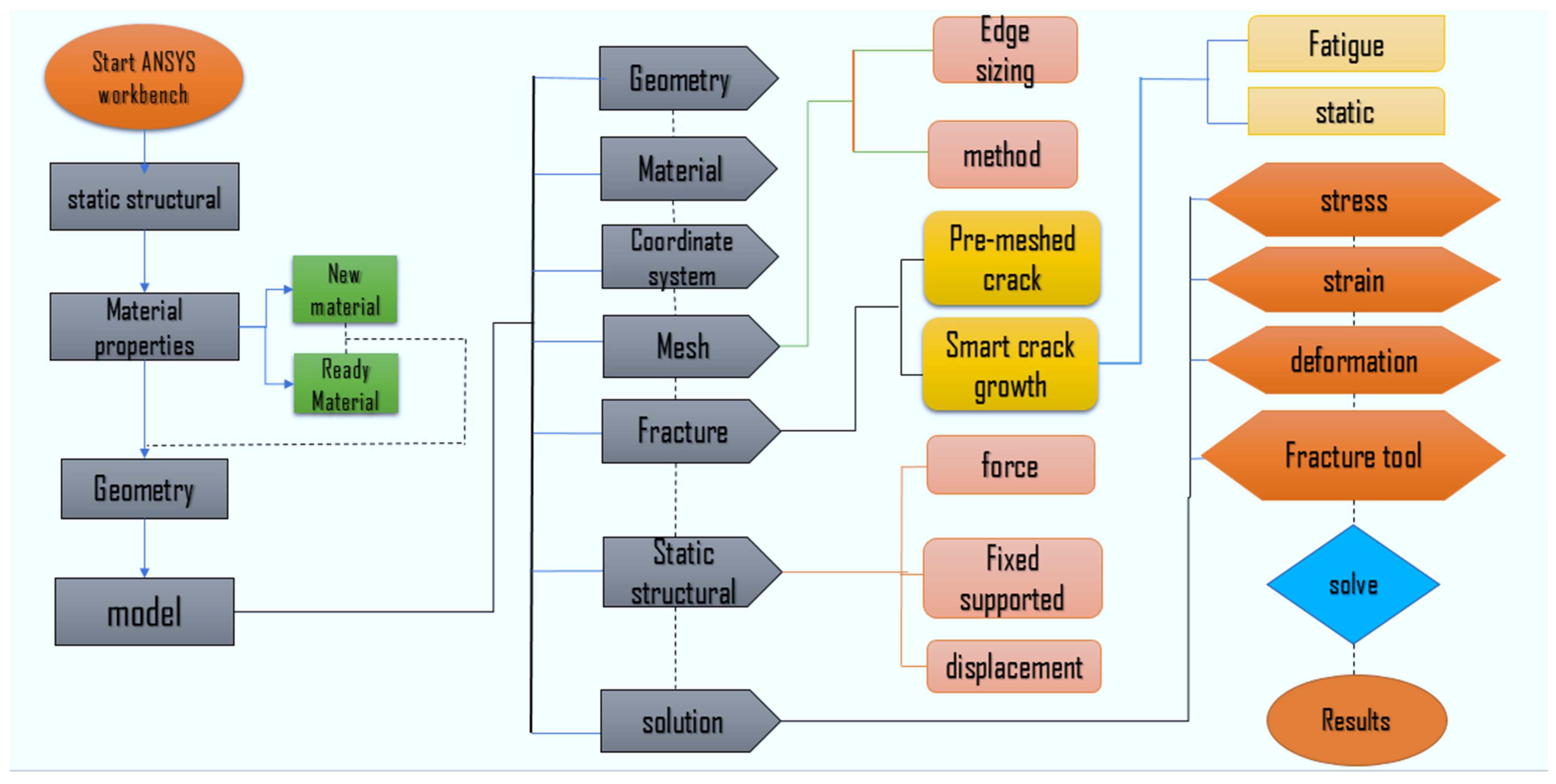
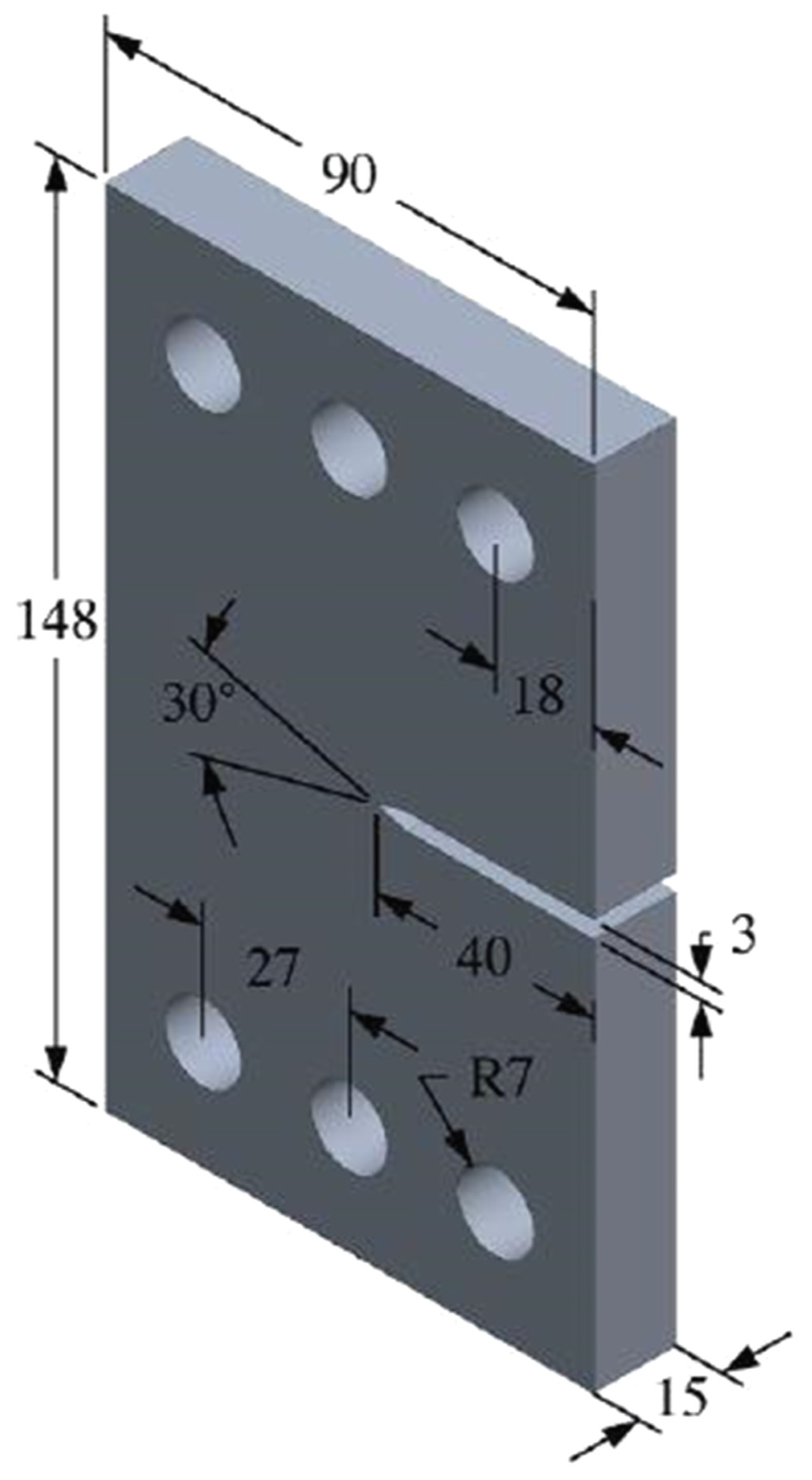

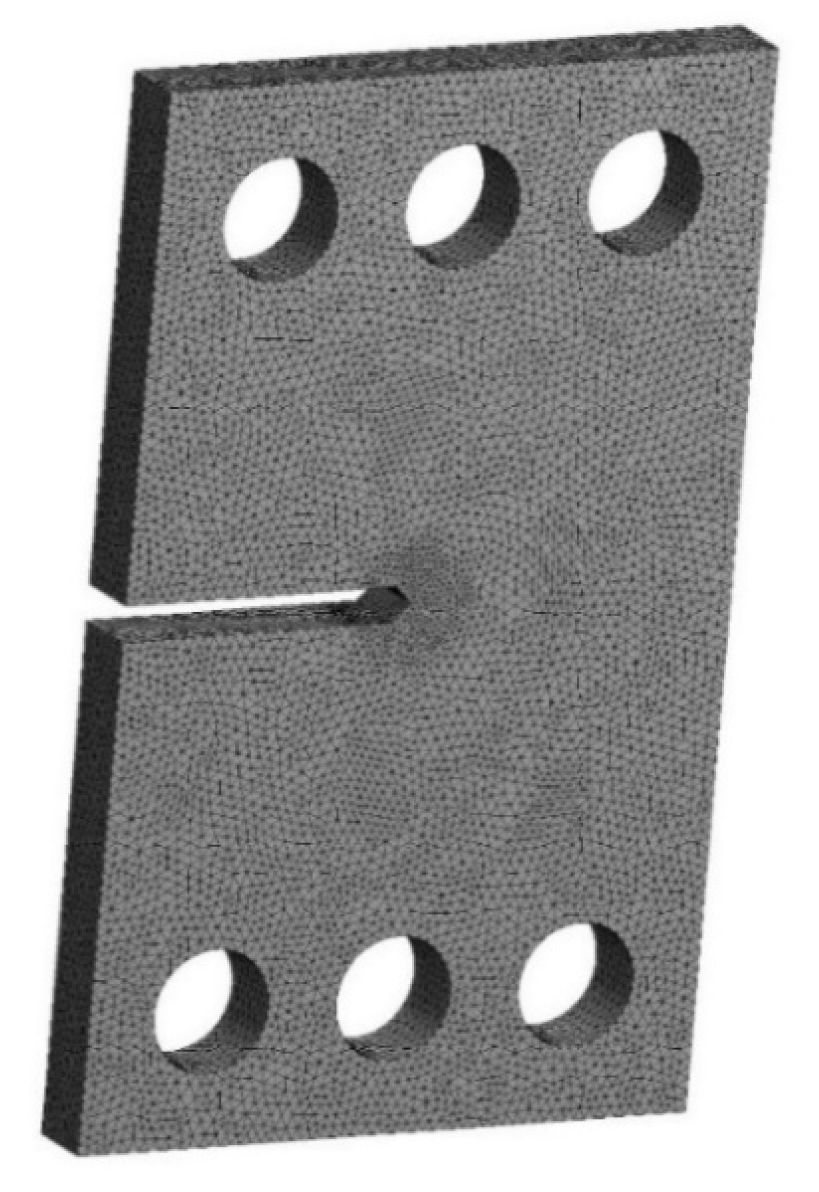


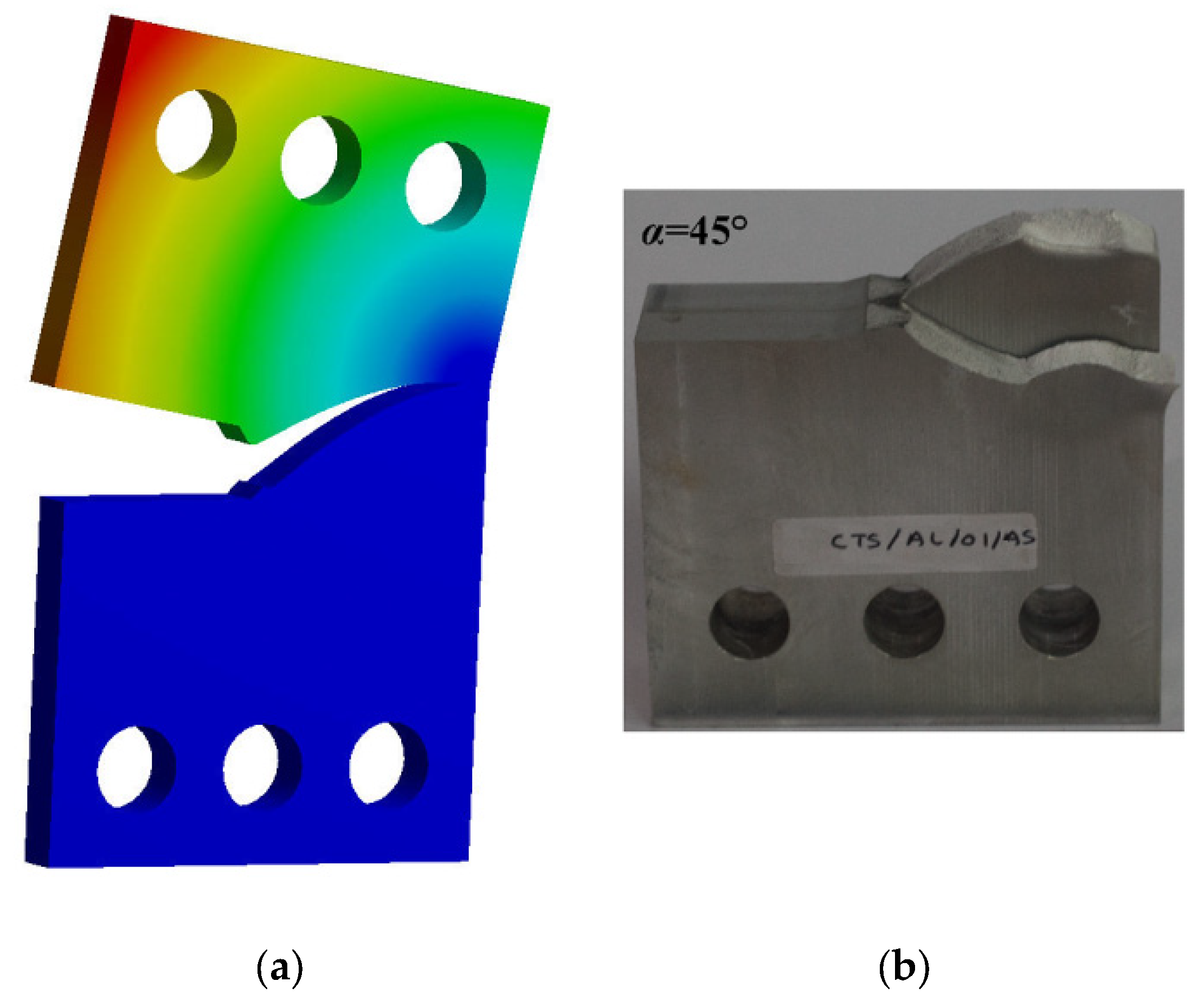
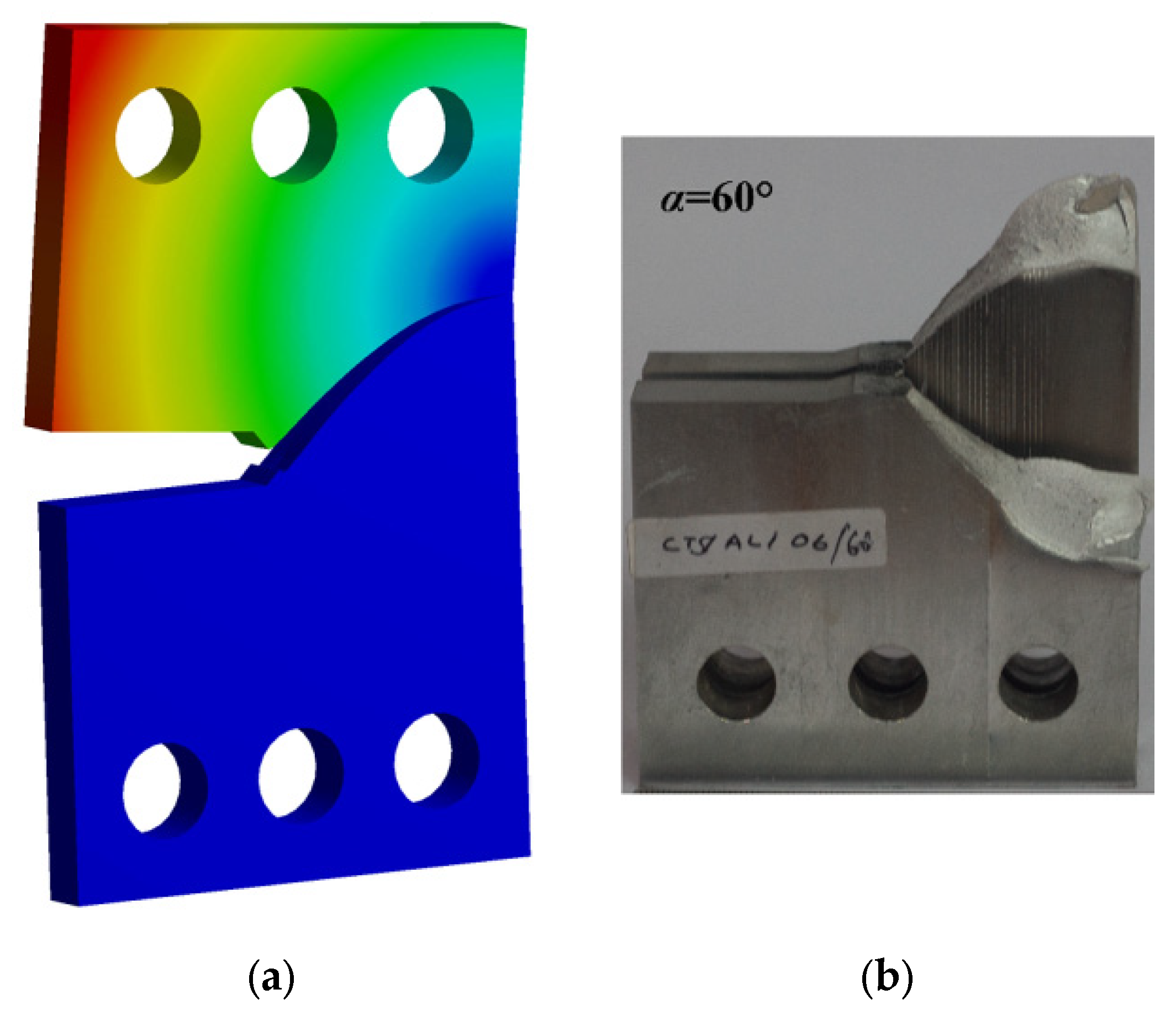

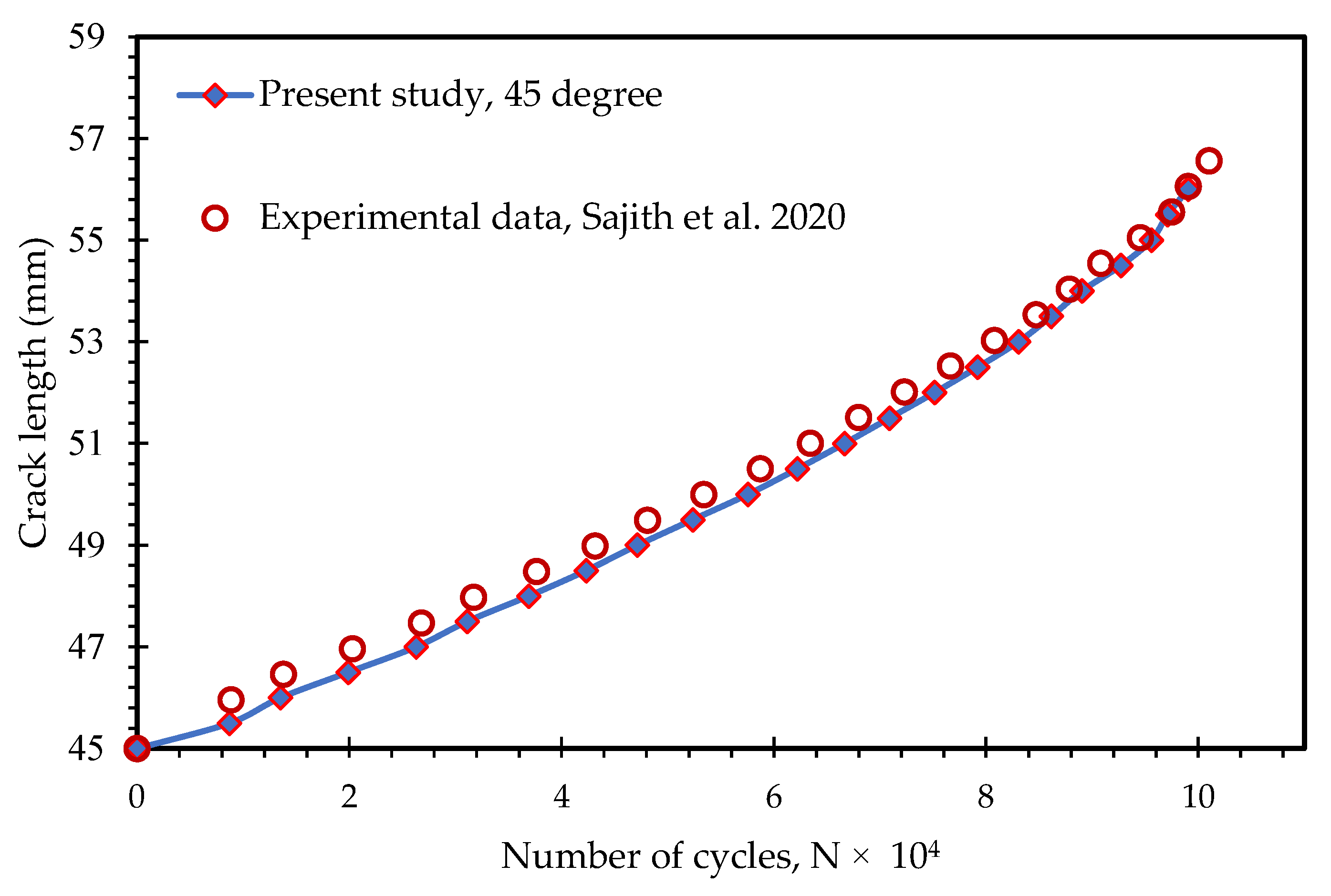
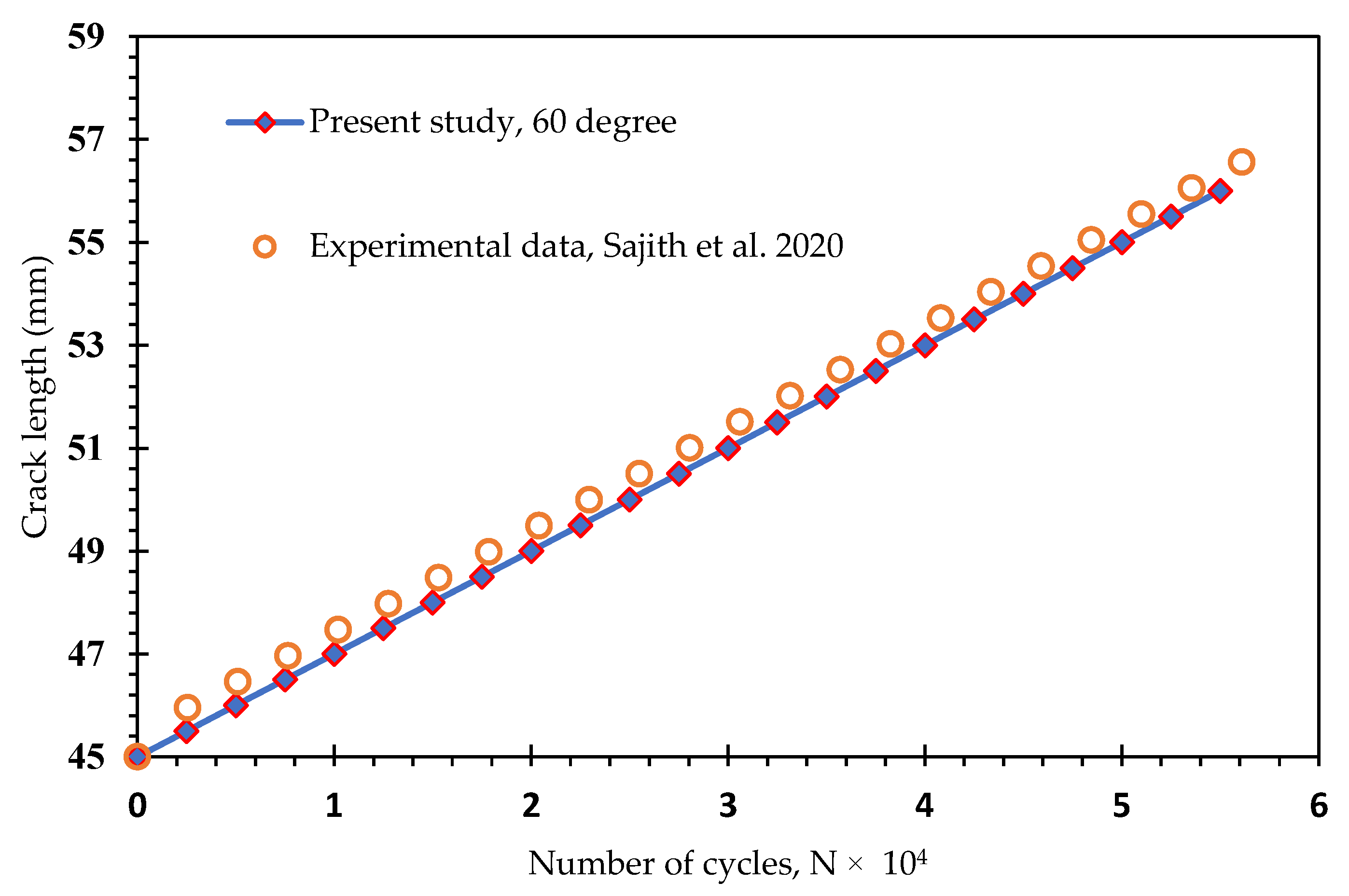
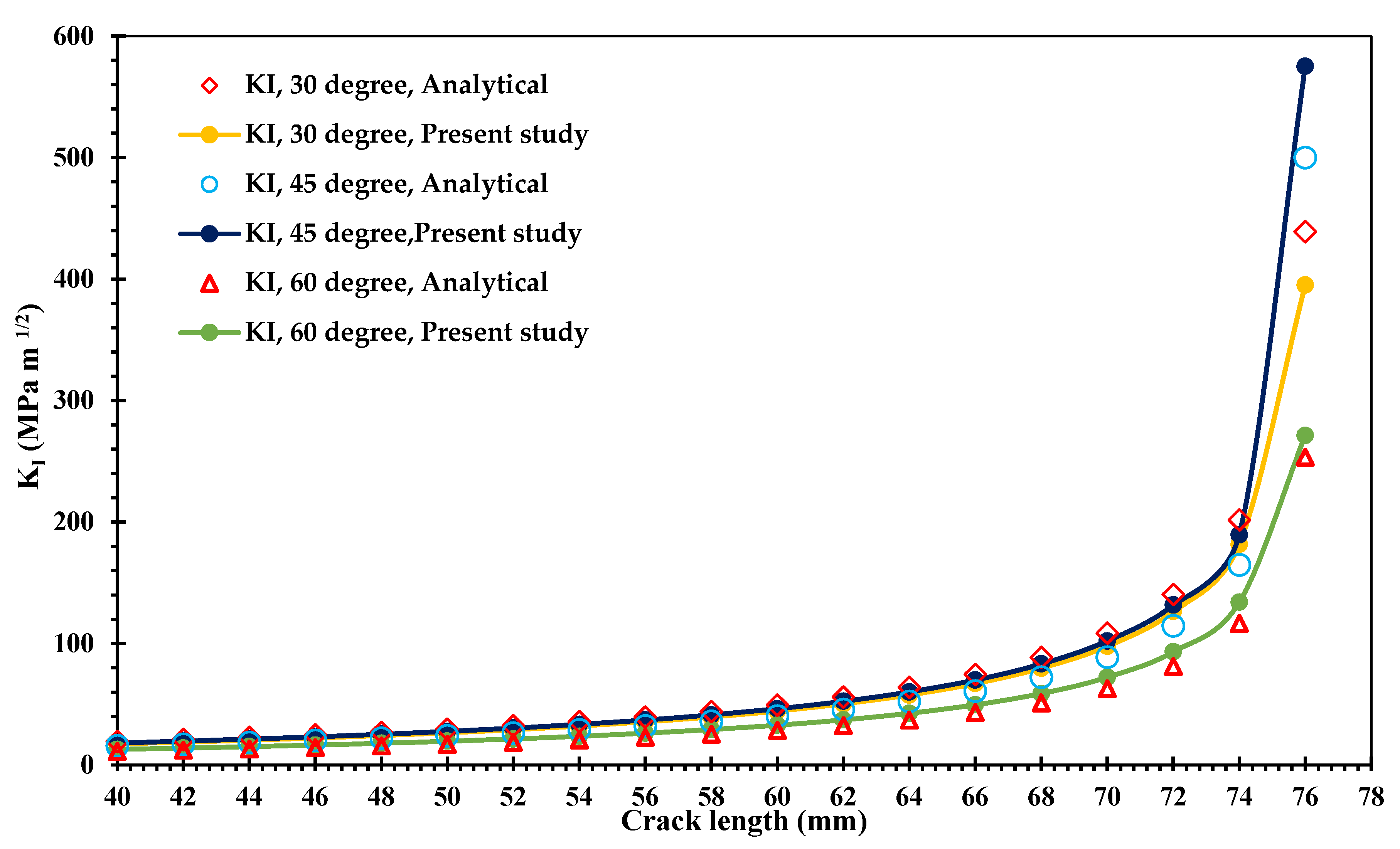
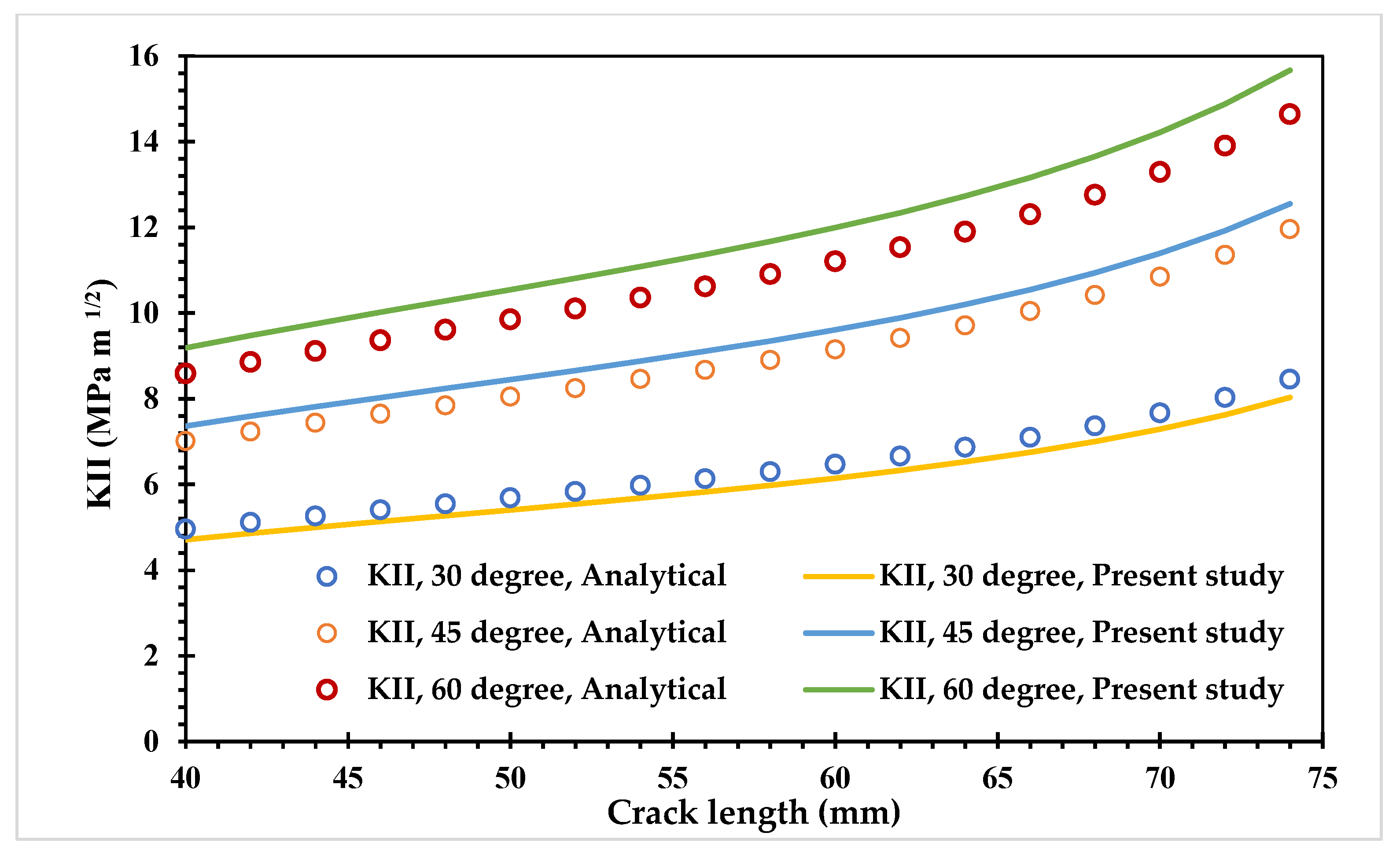

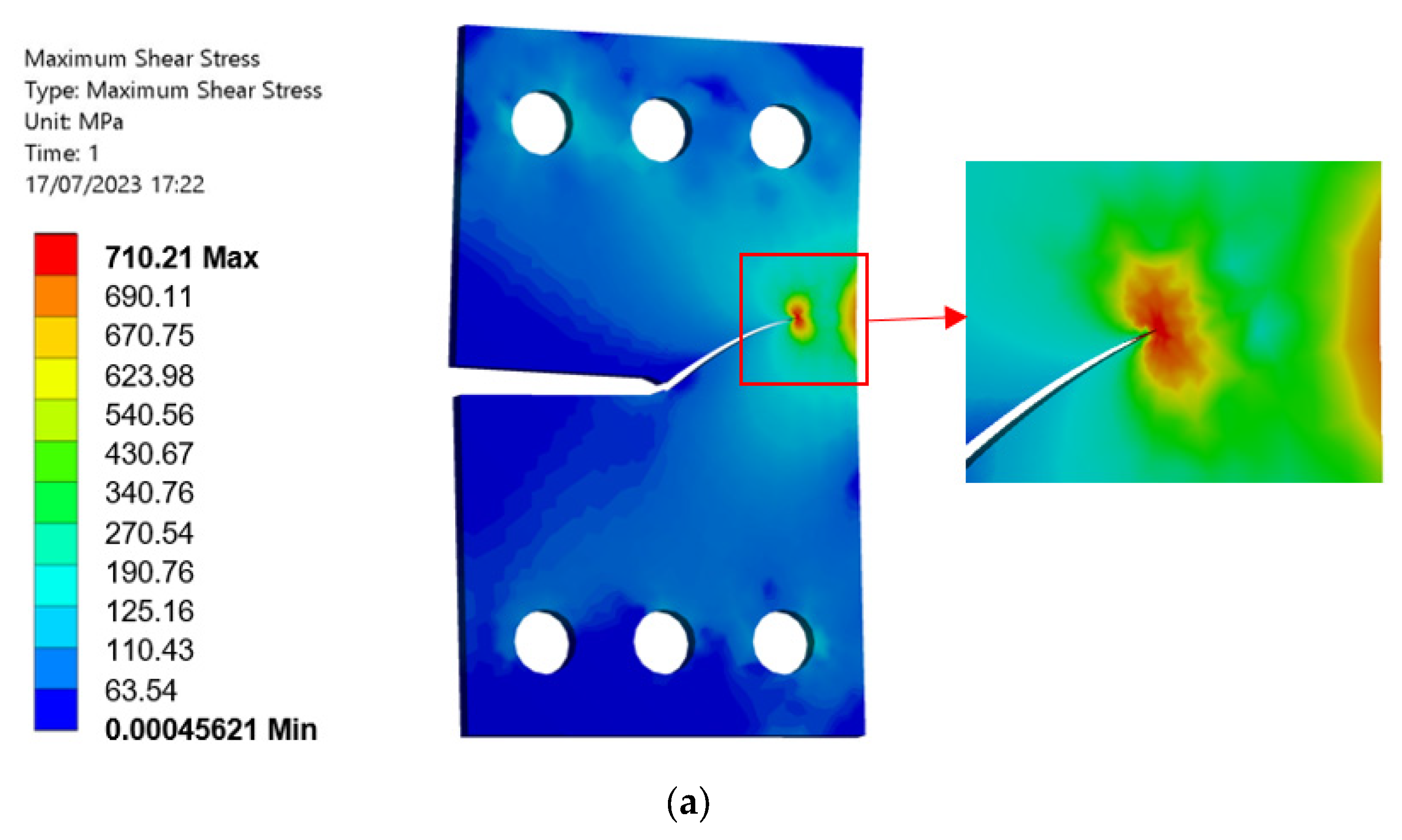
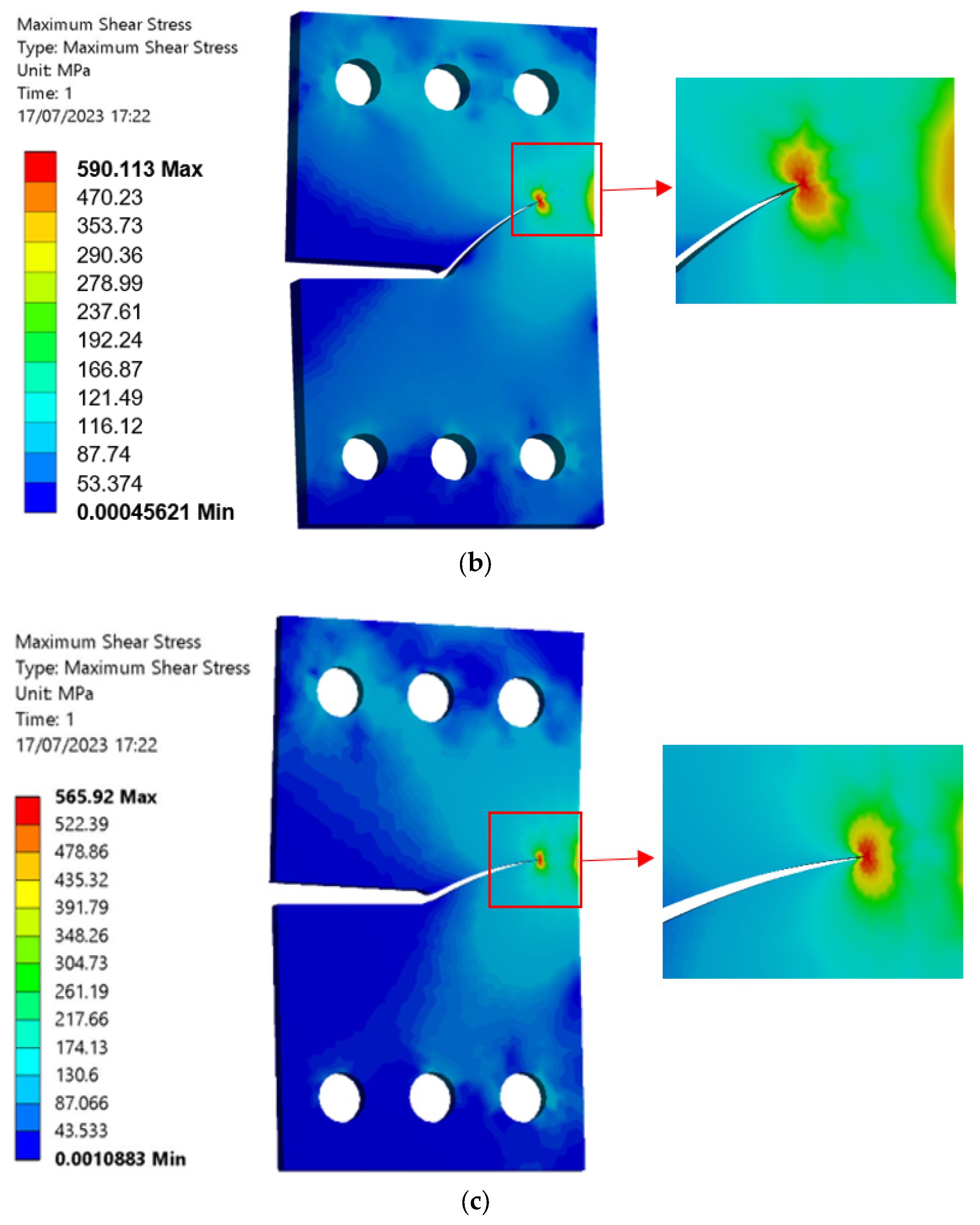
| Properties | Metric Units Value |
|---|---|
| Elasticity Modulus, E | 192 GPa |
| Poisson’s ratio, υ | 0.27 |
| Yield strength, σy | 295 MPa |
| Ultimate strength, σu | 582 MPa |
| Paris law coefficient, C | 4.051 × 10−8 |
| Paris law exponent, m | 2.348 |
| α | F2 | F1 | F3 |
|---|---|---|---|
| 30 | 0.5 F | 0.933 F | −0.067 F |
| 45 | 0.707 F | 1.061 F | −0.354 F |
| 60 | 0.866 F | 1.116 F | −0.616 F |
Disclaimer/Publisher’s Note: The statements, opinions and data contained in all publications are solely those of the individual author(s) and contributor(s) and not of MDPI and/or the editor(s). MDPI and/or the editor(s) disclaim responsibility for any injury to people or property resulting from any ideas, methods, instructions or products referred to in the content. |
© 2023 by the authors. Licensee MDPI, Basel, Switzerland. This article is an open access article distributed under the terms and conditions of the Creative Commons Attribution (CC BY) license (https://creativecommons.org/licenses/by/4.0/).
Share and Cite
Alshoaibi, A.M.; Bashiri, A.H. Fatigue Crack Growth Studies under Mixed-Mode Loading in AISI 316 Stainless Steel. Appl. Sci. 2023, 13, 9446. https://doi.org/10.3390/app13169446
Alshoaibi AM, Bashiri AH. Fatigue Crack Growth Studies under Mixed-Mode Loading in AISI 316 Stainless Steel. Applied Sciences. 2023; 13(16):9446. https://doi.org/10.3390/app13169446
Chicago/Turabian StyleAlshoaibi, Abdulnaser M., and Abdullateef H. Bashiri. 2023. "Fatigue Crack Growth Studies under Mixed-Mode Loading in AISI 316 Stainless Steel" Applied Sciences 13, no. 16: 9446. https://doi.org/10.3390/app13169446
APA StyleAlshoaibi, A. M., & Bashiri, A. H. (2023). Fatigue Crack Growth Studies under Mixed-Mode Loading in AISI 316 Stainless Steel. Applied Sciences, 13(16), 9446. https://doi.org/10.3390/app13169446









